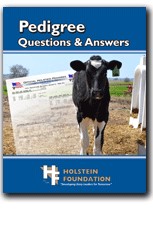Main Content

So, you have just selected or purchased a new dairy calf as 4-H project. You may have received a copy of the animal’s registration paper from the breed association and perhaps a copy of the animal’s official pedigree, also from the breed association. The pedigree gives you information about the genetic background of the animal. The genetic background can give you an indication of how well the animal will perform in the future, including milk production and genetic traits it can pass along to its progeny (or calves).
The pedigree would contain information about the sire (father or bull) and dam (mother or cow) of the animal. Most pedigrees list the maternal (mother or dam) side as well as the paternal (father or bull) side of the genetic make-up of an animal and include up to three generations on each side.
Knowing what factors to look for will help you select animals with pedigrees that may predict how well an animal will do in the show ring, how well an animal may do in the milking parlor, or how long an animal may last in your herd. The Holstein Association has a wonderful workbook on the subject that was released in 2018. This resource can help owners understand how cows are named and what percent purebred registered Holstein an animal might be.
If you have not checked out this resource yet, you may download a copy here.
Written by Carol K Ward, County 4-H Agent, Rutgers Cooperative Extension